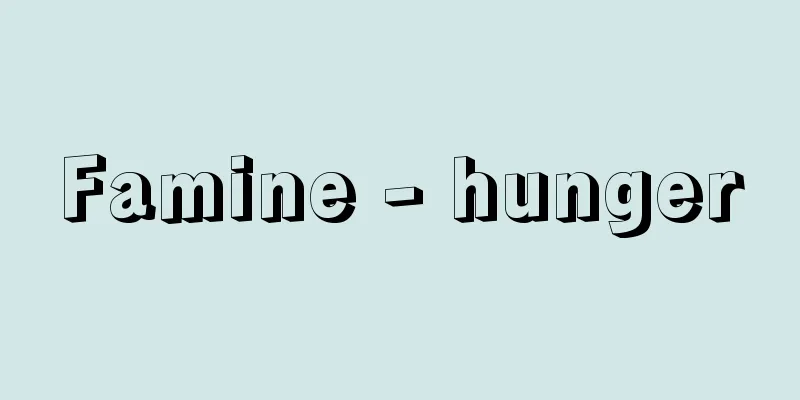Famine - hunger

|
Famines have occurred in various parts of the world since ancient times, causing misery. Generally speaking, in closed economic societies before the establishment of modern capitalist society, when the yield of agricultural products such as staple grains, miscellaneous grains, and potatoes, which are the main food source, decreased significantly, it caused an absolute shortage of food, and the deterioration of nutritional conditions often led to illness, death from disease, starvation, and starvation, as well as the emergence of many homeless people, and the exodus of the population to other areas, often occurring worldwide, nationally, or locally. Famines are such social abnormalities, but in Japan, although locally, they continued until the beginning of the Meiji era. Meanwhile, famines in Africa, the Middle East, and the Indian subcontinent are still extremely terrible and have become international political issues. Thus, even today, the problem of famine or starvation has not been resolved worldwide. On the contrary, the outlook for the future is by no means optimistic, and rather pessimistic predictions are being made. Famines are the most miserable problem for humanity, along with war. [Reikichi Susuda] CauseMany of the direct causes of famines are due to natural disasters, but the basic causes are deeply connected to problems in the political, socio-economic systems, and their history and specific manifestations vary greatly from region to region. Therefore, famines are both natural and man-made disasters. Natural disasters contain many social and man-made causes, and these two causes occur either alone or in conjunction with each other. Direct causes that have a significant bearing on the occurrence of famines are based on poor harvests caused by natural disasters such as drought, heavy rain, cold damage, wind and flood damage, insect damage, and volcanic eruptions. Agriculture, which is primarily intended to produce livestock and crops, which are plants and animals, cannot avoid bad harvests due to changes in natural conditions. The impact of changes in natural conditions is more pronounced when agricultural technology is underdeveloped and productivity is low. However, the second cause, political, socio-economic problems, is extremely important in understanding famines, and harsh policies by rulers have exacerbated famines. First, in premodern societies, the ruling class exacted severe taxes from direct producers, their territories were small, and transportation to distant areas was difficult due to underdeveloped means of transportation. Once a poor harvest hit, food shortages occurred immediately, and the damage spread and intensified, resulting in famine. Secondly, as a result of the blockade economy, in addition to nationwide famines, there were successive local famines, which were exacerbated by the prohibition of the transportation of food outside the territories controlled by the ruling class due to conflicts of interest. There are many specific issues that can be cited as factors that cause poor harvests to turn into famines, but the social causes of famines in peacetime can basically be summarized as the above two points. As for social causes, famines can also be caused by abnormal events such as war or civil unrest. For example, widespread destruction of cultivated land, loss of cultivation opportunities, the plundering of ripened crops by soldiers or armies of other territories or countries, or the complete destruction of the foundations of agricultural production are good examples. [Reikichi Susuda] Famine in JapanThe first record of a famine in Japan was in the "Nihon Shoki," which describes the 28th year of Emperor Kinmei's reign (567), when floods occurred all over the country, leading to starvation and the terrible situation of "people eating each other." Then, in the 34th year of the reign of Empress Suiko (626), it is recorded that "there was heavy rain from March to July, and the whole country became famine. The elderly ate grass roots and died by the roadside. The young children were still nursing, and both mother and child died" (ibid.). The cause of the great famine in 1181 (1st year of Youwa), at the end of the Heian period, was a rare drought that had occurred in the summer of the previous year, and the terrible situation was vividly described in Kamo no Chomei's "Hōjōki." Rice cultivation in western Japan was almost completely destroyed, and more than 40,000 people died of starvation in the capital, Kyoto, alone. During the period when the manor system was being dismantled, natural and man-made disasters occurred in a particularly overlapping manner, making famines even more devastating. In 1420-1421 (Oei 27-28), a famine occurred due to severe drought and war, and in 1460-1461 (Kansho 1-2), there is a record of an incredible famine in which "two-thirds of the people died" (Tachikawaji Chronicle), caused by severe cold damage and war. Around this time, peasant uprisings aimed at reducing or exempting taxes were at their peak. In 1539-1540 (Tenbun 8-9), another famine occurred due to wind and flood damage, insect damage, and war. In ancient and medieval times, rice cultivation was mainly done using rainwater on sloping land, so natural disasters such as poor harvests due to drought were the driving force behind famines. During the Tokugawa Shogunate and feudal domain system in the early modern period, there were dozens of famines, of which the Kyoho, Tenmei, and Tenpo famines are widely known as the three major famines of the early modern period. However, in recent years, the Kan'ei famine, which occurred during the establishment of the Shogunate and feudal domain system and has received little attention due to limitations in historical materials, has been attracting attention. The famine, which was caused by cold weather damage in 1641-1642 (Kan'ei 18-19), caused many people to starve to death. This famine was the direct trigger for the Shogunate to enact the "Eternal Prohibition of the Sale of Farmland" in the following year, 1643. This was a political measure taken to prevent the downfall of farmers who were forced to give up their land due to the famine, because the binding of farmers to their land was nothing but a basic condition for maintaining the Shogunate and feudal domain system. In this way, the Kan'ei famine contained various political, social, and economic contradictions in the feudal domain system. The Kyoho famine occurred in 1732-1733 (Kyoho 17-18) and is generally believed to have been caused by locust infestations. However, recent research by entomologists has revealed that the insect infestations in both years were caused by the simultaneous outbreak of planthoppers, aphids, leaf borers, two-banded grass moths, grass cutworms, and other pests. The following entry appears in a record from 1732: "This autumn, the fields of the western part of Japan, Shikoku, Chugoku, and Kinki are infested with insects that eat away at the ears of rice. Apparently, these insects are called Unka. (Omitted) They appear in the course of a night in their thousands, making a sound like they are munching on rice crackers, just like the sound of them greedily devouring rice. After devouring the rice, they scatter across mountain villages, gorge on leaves, and eventually fly off into the sea, their whereabouts unknown" (Shirasui Chisho). They have also appeared in Kyushu, but the Unka mentioned in the previous description is thought to be the Migratory Locust. A species of grasshopper other than the Migratory Locust has also appeared. This great famine caused by insect damage is worthy of special mention, as there have been no other examples in Japan before or after it. The famine caused many deaths from starvation; the number varies from book to book, but the Tokugawa Jikki states that it was about 970,000. Peasant uprisings broke out in rural areas, and riots broke out in cities. The Tenmei famine lasted from 1783 to 1787 (Tenmei 3 to 7), and the damage in 1783 and 1787 was particularly severe, affecting the entire country. The causes of the famine, which lasted several years, varied by region, but included rainstorms, floods, cold damage, and the eruption of Mount Asama, with cold damage causing the greatest damage. The famine in the Oshu region was particularly severe, and it is recorded that "approximately two million people died of starvation in the entire Oshu region" (Keisei Hisaku) in the three years after 1783. For example, in the Tsugaru domain, wind and rain continued from late April 1782, and cold damage continued even during the dog days. However, the domain authorities took the wrong measures, shipping 400,000 bales of rice to Edo and Osaka, and forcing the people to pay all of their taxes in rice. As a result, rice became scarce in the domain, the price of rice soared, and by May and June, rice sales had completely stopped. As autumn arrived, food ran out in the towns and cities alike, and people began to eat not only grassroots food but also the flesh of dead people, with many people dying of starvation on the roadside, creating a terrible sight. The Tenpo famine began in 1833 (Tenpo 4), was the direct result of a succession of abnormal weather conditions, and lasted for seven years until 1839 (Tenpo 10). As a precursor to the famine, cold damage, flooding, and epidemics occurred one after another at the end of the Bunsei era (1818-1830). From 1829 to 1831, poor harvests continued, mainly in eastern Japan, and from the spring of 1833, abnormal weather caused major flooding in Oshu and heavy rains and winds in Kanto. The harvest was normal in 1834, but in 1835, the Tohoku and Kanto regions suffered a poor harvest, and by 1836, the situation had spread to the Chugoku and Kyushu regions, with the national average harvest being 42% of the normal harvest, and in Oshu, which was hit the hardest, the poor harvest was 28%, resulting in a major disaster. There was a slight recovery in 1837-1838, but insect damage and epidemics continued, leading to another poor harvest in 1840, and the famine became even more severe. The aftereffects of the disaster continued even after 1840, making recovery difficult. The Oshio Heihachiro Rebellion of 1837 occurred in the midst of the Tenpo Famine. In order to avert a crisis in the feudal domain system caused by the Tenpo Famine, the shogunate carried out the Tenpo Reforms and worked to restore rural areas. In the early modern period, famines caused directly by natural disasters were mainly due to poor harvests caused by cold damage, with notable examples being the Tohoku famine of 1695-1696 (Genroku 8-9), the nationwide famine of 1701-1703 (Genroku 14-16), and the Kanto and Tohoku famines of 1755-1756 (Horeki 5-6) and 1866 (Keio 2). In the early modern period, the expansion of irrigation facilities led to the development of the alluvial plains of the large and medium-sized rivers and marshes along the coastline, and damage from droughts decreased relatively, but heavy summer rainfall and cold damage caused by cool temperatures caused poor harvests, which strengthened the tendency for famines to occur. According to common belief, there have been no famines caused by poor harvests since the Meiji era, but the "skyrocketing rice prices in 1869 and 1870 wiped out many lives across the country" and many people became ill due to malnutrition. Famines in Japan are also thought to be cyclical, and looking at the three major famines of the early modern period mentioned above, poor harvests occur in cycles of about 30 to 50 years. There was a severe famine in 1695 (Genroku 8), 53 years after the famine in 1642 (Kan'ei 19), there was another famine in 1732 (Kyoho 17), 37 years later, there was another famine in 1783 (Tenmei 3), 51 years later, there was another famine in 1833 (Tenpo 4), 50 years later, and 36 years later, there was another famine in 1869 (Meiji 2). Incidentally, Japan's total population stagnated at around 25 million from 1726 (Kyoho 11) to 1847 (Koka 4), the main cause of which was famine. [Reikichi Susuda] Foreign FamineGreat famines were particularly prevalent in India and China, and the direct causes of many of them were droughts and floods caused by irregular seasonal winds. In India, famines lasted for 12 years in 1148-1159 and 1396-1407. The latter famine killed one-third of the total population. Later, the famine of 1790-1792 is known as the Skull Famine, after the scattered corpses piled up to resemble a skull. The famine of 1899-1901 reduced the population by nearly 10 million people. Furthermore, the Bengal famine of 1943 killed 1.5 million people due to the interruption of rice transport due to the occupation of Burma (now Myanmar) by the Japanese army. China is known as a "country of famine," with 324 recorded floods, 167 droughts, and three major famines caused by insect pests during the Qing Dynasty (1616-1912) alone. Foreign Famine Relief Associations have reported that a major famine caused by drought in Shanxi and five other provinces from 1876 to 1877 killed 13 million people. Meanwhile in Europe, the infamous Irish potato famine of 1846-1847 caused over one million deaths from starvation, and many homeless people emigrated to the UK or the Americas. In modern times, the Biafran War of 1967 resulted in two million deaths on the Biafran side, including those killed in battle and those who died from starvation. The great famine in Bangladesh in 1973 was caused by flooding. In the current African continent, even if emergency food aid is provided during famines, underdeveloped transportation makes it difficult to transport it to the outskirts, making the famines even more devastating. [Reikichi Susuda] Famine in AfricaFamines occur frequently in the savanna and semi-desert regions of the African continent, which lie between the tropical rainforests and the deserts at the other end of the spectrum. Many of the people who live in these regions are pastoralists. These regions do not receive enough rainfall to support agriculture. Pastoralists make a living by converting plant resources that cannot be used directly as food into usable forms through their livestock. Desertification is progressing in these arid regions. For example, in the Sahel region, which is on the southern edge of the Sahara Desert in West Africa, it has been reported that the desert has moved 200 kilometers south in the past 200 years. However, when examining climate change over the past century or so based on records of changes in the water levels of inland lakes and rivers and precipitation, there is no overall tendency for precipitation to decrease continuously. In other words, if we limit ourselves to this period, we cannot say that the African climate is becoming drier. Droughts caused by little rain are thought to be the direct cause of the famines that have repeatedly struck the African continent in recent decades. However, this little rain is not abnormal weather, but rather a phenomenon that occurred within the range that can be expected to occur in this continent, where precipitation fluctuates greatly. However, desertification is a reality. In 1984, the Food and Agriculture Organization of the United Nations (FAO) reported that 150 million people in 24 African countries were suffering from food shortages, with the majority of these people living in these arid regions. From an ecological point of view, the organic structure of the ecosystem in arid regions is small and simple, and a delicate balance is maintained. The destruction of this balance by human activity has brought about desertification of the land. The basic cause of this imbalance lies in historical changes in land use patterns. The cultivation of commercial crops was introduced to African countries by their former colonial powers during the colonial period, and continued as a means of earning foreign currency even after independence. This agriculture pushed traditional self-sufficient agriculturalists into arid regions, where they engaged in intensive land use that was unsuitable for the land, causing topsoil erosion. Furthermore, the influx of agriculturalists restricted pastoralists' living areas to drier regions, causing overgrazing of livestock and cutting down trees for buildings and fuel, accelerating desertification of the land. African countries that gained independence one after the other after the 1960s were plagued by political turmoil, wars and internal conflicts, failed economic and agricultural policies, and inadequate medical services, among other political and social problems, which made them unable to cope with famines caused by drought. However, the fundamental cause of famines on the African continent is the over-exploitation of the natural environment that accompanied the unplanned expansion of agriculture by commercial capital and the process of political centralization that supported it. The African continent is subject to significant climate change, and these fluctuations are difficult to predict. It can be said that famines on this continent were inevitably brought about by the pursuit of limitless economic growth in a land characterized by extreme climate change. People who lost their livestock to the drought and could no longer maintain their pastoral lifestyle flowed into cities, forming slums on the outskirts, some of whom became wage laborers. It is also predicted that the traditionally egalitarian pastoral society without internal hierarchy will be transformed into a hierarchical society in the midst of the wave of modernization, as a direct result of the increase in wealth due to the drought. [Ota Itaru] Measures and assistanceIn developing countries that have been colonies or semi-colonies for a long time, the political, socio-economic status of the general public is still low and unstable. Furthermore, in countries where political conflicts are intensifying, natural disasters, civil wars, wars, and population problems are all overlapping, causing hunger in many cases. To solve the hunger problem in such countries, developed capitalist countries have tried to increase food production through birth control and technical assistance to increase agricultural productivity from a humanitarian standpoint, but neither population control nor food production policies have been very effective. Agricultural technical assistance for "liberation from hunger" and "overcoming poverty" has been implemented in various places, particularly in Africa and Southeast Asia, through the construction of large dams, the expansion of water facilities, the introduction and dissemination of improved crop varieties, chemical fertilizers, and pesticides. In response to the food crisis caused by abnormal weather worldwide in 1972, the World Food Conference was held in Rome in 1974, and the "World Declaration on the Eradication of Hunger and Malnutrition" was unanimously adopted. This resolution is not limited to the issue of hunger in developing countries, but is a call for international cooperation to solve the world's food problems. It is said that there are 800 million people in developing countries who are "absolutely poor" (suffering from malnutrition, high infant mortality rate, short life expectancy, lack of literacy education, and other deplorable conditions) and who are far from a decent life, making up nearly a quarter of the world's population. [Reikichi Susuda] "A History of Famine in Early Modern Japan," edited by Ono Takeo (1935, Gakugeisha)" ▽ " A Study of the History of Savagery in Japan," edited by Nishimura Makoto and Yoshikawa Ichiro (1936, Maruzen; reprint edition, 1983, Ariake Shobo)" ▽ "A History of Disasters in Japan," edited by Ogoshi Doka (1967, Chijin Shokan)" ▽ "Documents on Famine in Japan, edited by the Criminal Affairs Bureau of the Ministry of Justice (1977, Hara Shobo)" ▽ "A History of Famine in Japan," written by Nakajima Yoichiro (1981, Yuzankaku Books)" ▽ "Famine," written by Arakawa Hidetoshi (Kyouikusha Rekishi Shinsho)" ▽ "The Structure of Hunger," written by Nishikawa Jun (1985, Diamond Inc.) This painting depicts disaster victims being taken in and protected in a relief hut during a famine. Watanabe Kazan's "Relief for Rural Exiles" 1838 (Tenpo 9), owned by the National Diet Library . The Tenpo Famine Source: Shogakukan Encyclopedia Nipponica About Encyclopedia Nipponica Information | Legend |
|
飢饉は古来世界の各地に発生し悲惨な状態を引き起こしてきた。一般的にいって、近代資本主義社会が成立する以前の封鎖経済的な諸社会においては、食糧の中心をなす主穀、雑穀、いも類などの農業生産物の収穫量が顕著に減少すると、食糧の絶対的な欠乏をきたして、栄養状態の悪化に伴う病人、病死者、飢餓人、餓死者、さらには多くの浮浪者の発生、および他の地域への人口の流亡をしばしば世界的に、国内的に、あるいは地方的に発生させてきた。飢饉はこうした社会的な異常現象であるが、日本では局地的にではあるにせよ、明治の初年まで続いた。一方、世界的には現在もアフリカ、中近東およびインド亜大陸における飢饉は酸鼻を極め、国際的な政治問題となっている。このように世界的には、現代においても飢饉ないしは飢餓の問題は解決されていない。それどころか将来の展望はけっして楽観的なものではなく、むしろ悲観的な予測がなされている。飢饉は人類にとって、戦争と並んでもっとも悲惨な問題である。 [須々田黎吉] 原因飢饉の直接的な原因の多くは自然的な災害に起因しているが、基本的な原因は政治社会経済的な体制の問題と深くかかわっており、その歴史、具体的な現れ方は地域によってきわめて多様である。したがって飢饉は天災であると同時に人災でもある。自然災害には社会的な原因、人災が多分に含まれているから、この二つの原因が単独に、あるいは関連しあって発生する。飢饉の発生に重大な関係を有する直接的な原因は、干魃(かんばつ)、霖雨(りんう)、冷害、風水害、虫害、噴火などの自然災害による凶作に基づいている。本来、動植物である家畜、作物の生産を目的とする農業においては、自然条件の変動による豊凶から免れることはできない。農業技術の未発達な生産力の低い段階におけるほど、自然条件の変動による影響は顕著に現れる。 しかし第二の原因たる政治社会経済的な問題は、飢饉を理解するうえにおいてきわめて重要な意義を有し、為政者の過酷な政策が飢饉をいっそう激化させてきた。第一に、前近代の諸社会においては、支配階級の直接生産者からの租税収奪が厳しく、また支配領域も狭隘(きょうあい)で、交通手段の未発達による物資の遠隔地への輸送も困難であったため、いったん凶作に襲われると、たちまち食糧不足をきたし、その被害が拡大、激化して飢饉を発生させる結果となった。第二に、封鎖経済に起因するものとして、全国的な飢饉以外に地方的な飢饉の続発をあげなければならないが、これは支配階級の利害対立に基づく支配領域外への食糧の輸送禁止によって地域的な飢饉をさらに激化させた。凶作の飢饉化の要因については具体的には幾多の問題をあげうるが、平和時における飢饉の社会的原因として基本的には以上の2点に要約することができる。さらに社会的な原因として、戦争や内乱などの異常事態によって飢饉を引き起こす場合もある。たとえば、広範囲にわたって耕作地を踏み荒らされたり、また耕作の機会を失ったり、あるいは他領、他国の兵士、軍隊によって実った農作物を強奪されたり、さらには農業生産の基盤を徹底的に破壊されたりすることなどは、その好例である。 [須々田黎吉] 日本の飢饉日本の飢饉が最初に記録に表れたのは『日本書紀』で、欽明(きんめい)天皇28年(567)各地に大水が出て人々が飢え、「或(あるい)は人相喰(は)む」惨状が述べられている。ついで推古(すいこ)天皇34年(626)には、3月より7月にかけて「霖雨あり、天下大いにこれより飢ゆ。老者は草の根を食ひ道のほとりに死ぬ。幼者は乳をふくみ以(も)って母子共に死ぬ」(同前)と記録されている。平安時代末期、1181年(養和1)の大飢饉の原因は、前年夏の史上まれにみる大干魃によるもので、その惨状は鴨長明(かものちょうめい)の『方丈記』に活写されている。西日本の稲作が皆無に近い被害を被り、都の京都だけでも4万人以上の餓死者を出した。荘園(しょうえん)制の解体期には天災と人災とがとくに重層化して起こり、飢饉をいっそう悲惨なものにした。1420~1421年(応永27~28)には大干魃と戦乱による飢饉が発生し、また1460~1461年(寛正1~2)には大冷害と戦乱などによって「人民の死するもの三分の二に及ぶ」(『立川寺年代記』)という信じがたいほどの大飢饉の記録が残されている。この前後は年貢の減免を目的とした土一揆(つちいっき)の最盛期であった。また1539~1540年(天文8~9)にも風水害、虫害、戦乱などによる大飢饉が起こった。上古および中世の稲作はおもに傾斜地における天水利用であったから、自然災害は干魃による凶作が動因となって飢饉を引き起こしている。 近世の徳川幕藩体制期には数十回の飢饉が発生し、なかでも享保(きょうほう)、天明(てんめい)、天保(てんぽう)の飢饉は近世三大飢饉としてあまねく知られているが、近年これまで史料的な制約もあって注目されることの少なかった幕藩体制確立期における寛永(かんえい)の飢饉が着目されてきた。1641~1642年(寛永18~19)の両年にわたる冷害に基づく飢饉によって、多くの餓死者を出した。この飢饉が直接的な契機となって、翌1643年に幕府は、「田畑(でんぱた)永代売買禁止令」を制定した。それは、飢饉によって土地を手放さざるをえなかった農民の転落を防止するためにとられた政治的措置であって、農民の土地への緊縛は幕藩体制を維持するための基本条件にほかならないからである。このように寛永の飢饉は、幕藩体制の政治社会経済的な種々の矛盾を内包していた。 享保の飢饉は1732~1733年(享保17~18)に発生し、その原因は一般に蝗害(こうがい)によるものとされている。だが昆虫学者の最近の研究によって、この両年に発生した虫害はウンカ類、アブラムシ類、メイチュウ類、フタオビコヤガ、クサキリ、およびその他の害虫が一斉に発生したことに原因していることが明らかになった。1732年の記録に以下の記述がみられる。「この秋西国、四国、中国、近畿一帯の田畑に虫害附き稲の穂を喰(くい)荒らす。此(この)虫のことを雲賀(うんか)という由(よし)。(中略)一夜の中に幾万と涌出(わきい)で、稲をむさぼり喰う音さながら煎餅(せんべい)を噛(か)むが如(ごと)し。やがて米穀を喰荒して後は山村に飛び散りて葉を暴食し、果ては海中に飛去りて行方知れずという事なり」(白水痴書)。九州にも発生しているが、前の記述にみられる雲賀は飛蝗(トノサマバッタ)と推察されている。飛蝗とは異なるバッタ類も発生した。日本では虫害によるこうした大飢饉は前後に類例をみないだけに、特筆すべき価値がある。この飢饉によって餓死者が続出し、その数は諸書によって一致しないが、『徳川実紀』にはおよそ97万人と記されている。農村では百姓一揆が、都市では打毀(うちこわし)が発生した。 天明の飢饉は1783~1787年(天明3~7)の長期にわたり、ことに1783年と1787年の被害は甚大で、その範囲は全国にわたった。数年に及ぶ飢饉の原因は、地方によって異なるが霖雨、水害、冷害、浅間山の大噴火などで、冷害による被害がもっとも大きかった。なかでも奥羽地方の飢饉は激甚を極め、1783年以後3か年「奥州一箇国の餓死人数凡(およそ)二百万人余」(『経世秘策』)と記録されている。一例をあげれば、津軽藩では1782年4月下旬より風雨が続き、土用に至っても冷害が続いた。しかるに藩当局は措置を誤り、40万俵を江戸、大坂に廻米(かいまい)、上納はすべて米納を強制した。このため藩内の米穀は欠乏し、米価は高騰して5、6月には米の売買はまったくやんだ。秋に入るや町方在方を問わず食物は尽き、草の根はもとより、さらに死人の肉まで食い、路傍に餓死者が続出し、目を覆う惨状を呈するに至った。 天保の飢饉は1833年(天保4)に始まり、相次ぐ異常気象が直接に原因し、1839年(天保10)までの7年間にわたって発生した。その前兆として文政(ぶんせい)(1818~1830)末年にはすでに冷害、水害、疫病の流行が続出した。1829~1831年には東日本を中心に不作が続き、1833年には春から異常気象により奥州に大洪水、関東に大風雨が発生した。1834年には平年作であったが、1835年には東北、関東地方が凶作となり、1836年には中国、九州地方まで拡大し、作況は全国平均で平年作の42%、被害のもっとも激しかった奥州では28%の大凶作となり大惨事に至った。1837~1838年にはやや回復したが、虫害、疫病などが続き、1840年にもまた凶作となり、さらに飢饉の惨状は拡大し、深刻な様相を呈した。1840年以後にも災害の余波が続き容易に回復しなかった。1837年の大塩平八郎の乱は天保飢饉のさなかに起こった。幕府は天保の飢饉による幕藩体制社会の危機を回避するために、天保の改革を行って農村の復興にあたった。 近世の自然災害を直接の動因とする飢饉は、おもに冷害による凶作に起因するものが多く、その代表的なものとして、1695~1696年(元禄8~9)の東北の飢饉、1701~1703年(元禄14~16)の全国的飢饉、1755~1756年(宝暦5~6)、および1866年(慶応2)の関東、東北地方の飢饉がとくに知られている。近世には灌漑(かんがい)施設の拡充によって大中河川の沖積平野あるいは海岸線に存在した湿地の開発が進み、干魃による被害は相対的に低下し、夏期の多雨、冷温による冷害が凶作を引き起こし、これが飢饉に至らしめる傾向を強くした。 通説によれば、明治以後は大凶作による飢饉はなかったとされているが、「明治二、三年ノ米価暴騰ハ全国幾多ノ人命ヲ絶滅セシ」め、あるいは栄養不良による多くの病人を出した。日本の飢饉には周期性があるとも考えられ、前記の近世三大飢饉前後をみても、ほぼ30年から50年の周期で凶作が起こっている。1642年(寛永19)の凶作から53年を経た1695年(元禄8)に大凶作、37年を経た1732年(享保17)に大凶作、51年を経た1783年(天明3)に大凶作、50年を経た1833年(天保4)に大凶作、36年を経た1869年(明治2)に大凶作が起こっている。ちなみに1726年(享保11)から1847年(弘化4)にかけての日本の総人口は2500万人前後に停滞したが、そのおもな原因は飢饉であった。 [須々田黎吉] 外国の飢饉世界のなかでも大飢饉はとくにインドや中国に顕著で、その直接的な原因は不規則な季節風に基づく干魃や水害によるものが多かった。インドでは1148~1159年、1396~1407年、それぞれ12年間にわたって飢饉が続いた。後者の飢饉は全人口の3分の1の死者を出した。下って1790~1792年の飢饉は、散乱した死体が積み上げられた髑髏(どくろ)となったのにちなんで、髑髏飢饉として知られている。1899~1901年の飢饉では1000万人近い人口が減少した。さらに1943年のベンガルの飢饉は、日本軍のビルマ(現、ミャンマー)占領による米の輸送途絶によって死者150万人を出した。中国は「飢饉の国」の名があるように、清(しん)朝時代(1616~1912)のみについてみても324回の水害、167回の干魃、3回の虫害による大飢饉が記録されている。外国の飢民救済会は、1876~1877年にかけて山西省ほか5省で起こった干魃による大飢饉で1300万人の人口が死滅したことを報告している。 一方ヨーロッパでは、1846~1847年にかけて起こった史上有名なアイルランドのジャガイモ飢饉によって、100万を越す餓死者を出し、多数の浮浪者がイギリス本土やアメリカ大陸に移民した。現代においては、1967年に起こったビアフラ戦争で、ビアフラ側は戦死、餓死を含めて200万に及ぶ死者を出した。また1973年のバングラデシュの大飢饉は水害に起因するものであった。なお現在のアフリカ大陸では、飢饉の際に食糧物資の緊急援助があっても、交通手段の未発達が末端への輸送を困難にし、それが飢饉をいっそう悲惨なものにしている。 [須々田黎吉] アフリカの飢饉問題アフリカ大陸において飢饉が頻発しているのは、熱帯降雨林と、その対極の砂漠との間に広がるサバンナおよび半砂漠地帯であり、この地域に住む人々の多くは牧畜民である。その地域は、農耕を行いうるほどには降水量がない。牧畜民は、直接には食物にはしえない植物資源を、家畜を通して利用可能な形に変換して生活しているのである。 こうした乾燥地域では、砂漠化が進行している。たとえば西アフリカのサハラ砂漠の南縁部のサヘル地帯では、過去200年間に砂漠が200キロメートル南下したという報告がある。しかしながら、過去百数十年間の気候の変化を、内陸湖や河川の水位変化や降水量の記録によって検討してみると、全体として降水量が連続的に減少しているという傾向はみられない。つまり、この期間に限定する限り、アフリカの気候が乾燥化に向かっているとはいえないのである。最近の数十年間に繰り返してアフリカ大陸を襲った飢饉の直接的な原因と考えられているのは少雨による干魃(かんばつ)である。しかしながらこの少雨は、異常気象ではなく、むしろ降水量の変動が大きいこの大陸としては、生起しうると予想される範囲でおこった現象であるということになる。 しかし、土地の砂漠化は実際に進行している。1984年には、国連食糧農業機関(FAO)は、アフリカの24か国、1億5000万人が食糧不足にみまわれていると報告したが、この大部分の人は、こうした乾燥地域で生活している。乾燥地域を生態学的な観点からみれば、その生態系の有機的な構造は小さく、かつ単純であり、バランスは微妙に保たれている。そのバランスの人為的な破壊が、土地の砂漠化をもたらしたのである。 バランスを崩壊させた基本的な原因は、土地利用形態の歴史的な変化にある。アフリカ諸国には、商品作物の栽培が植民地時代に旧宗主国によって導入され、独立後も外貨獲得手段として継続された。その農業は、伝統的な自給自足の農耕民を乾燥地域へと押し出し、農耕民は、その土地には不適当な集中的土地利用を行って、表土を流出させた。そして、農耕民流入によって、より乾燥した地域に生活域を限定された牧畜民は、家畜の過放牧を引き起こし、また、建築物や燃料用に樹木を伐採して、土地の砂漠化を進行させたのである。 1960年代以後に次々に独立したアフリカ諸国は、政治の混迷、戦争や内紛、経済・農業政策の失敗、医療サービスの不備などの政治・社会的問題を抱えており、それらが干魃による飢饉に対処しえない要因をなしている。しかし、アフリカ大陸の飢饉の根本的な原因は、商業資本による農業の無計画な拡張、そしてそれを支えた政治的な中央集権化の過程に伴う、自然環境の過剰利用にある。アフリカ大陸は気候変動が大きく、その変動は予測しにくい。この大陸の飢饉は、激しい気候変動という特性を抱えた土地において、際限のない経済成長が追求されることによって、必然的にもたらされたといえよう。 干魃によって家畜を失い、牧畜生活を維持できなくなった人々は、都市へ流入して周辺部で貧困街を形成し、その一部分は賃金労働者となっていく。また、伝統的には内部に階層のない平等主義的な牧畜民社会が、干魃による貧富の増大を直接的な契機として、近代化の波のなかで階層社会へと変容していくという過程も予想されている。 [太田 至] 対策と援助長い間植民地、半植民地であった開発途上国などでは、現在もなお一般国民の政治社会経済的な地位が低く、かつ不安定な状態に置かれている。さらに政治的対立の激化している国々では、自然災害に加えて内乱や戦争、さらには爆発的に増加する人口問題が重なり合って、飢餓状態を引き起こしている場合も少なくない。そうした国々の飢餓問題の解決策として、先進資本主義諸国は人道主義の立場から、産児制限および農業生産力を高めるための技術援助を通じて、食糧の増産を図ってきたが、人口抑制政策も食糧増産政策もなお十分な成果をあげているとはいえない。「飢餓からの解放」や「貧困の克服」のための農業技術援助は、具体的にはアフリカや東南アジア諸国をはじめ、各地に巨大なダムの建設、水利施設の拡充、作物の改良品種、化学肥料、農薬などの導入、普及を通じて実施されてきた。1972年の世界的な異常気象による食糧危機を契機に、1974年ローマで世界食糧会議が開かれ、「飢餓及び栄養不良の撲滅に関する世界宣言」を全会一致で採択した。この決議は、開発途上国の飢餓問題にとどまらず、広く世界の食糧問題を解決するための国際協力の性格をもつものである。開発途上諸国には、およそ人間らしい生活からほど遠い「絶対的貧困者」(栄養不良、高い幼児死亡率、短い平均寿命、識字教育の不足などの劣悪な状態)が、世界総人口のほぼ4分の1近い8億も存在するといわれている。 [須々田黎吉] 『小野武夫編『日本近世饑饉志』(1935・学芸社)』▽『西村真琴・吉川一郎編『日本凶荒史考』(1936・丸善/復刻版・1983・有明書房)』▽『小鹿島果編『日本災異志』(1967・地人書館)』▽『司法省刑事局編『日本の飢餓資料』(1977・原書房)』▽『中島陽一郎著『飢餓日本史』(1981・雄山閣ブックス)』▽『荒川秀俊著『飢餓』(教育社歴史新書)』▽『西川潤著『飢えの構造』(1985・ダイヤモンド社)』 飢饉の際、救小屋に収容され保護を受ける罹災民を描いたもの。渡辺崋山画『荒歳流民救恤図』 1838年(天保9)国立国会図書館所蔵"> 天保の飢饉 出典 小学館 日本大百科全書(ニッポニカ)日本大百科全書(ニッポニカ)について 情報 | 凡例 |
>>: Return and Commemoration - Kikyorai no Ji
Recommend
Letnii sad (English spelling) Letniisad
…The Admiralty Palace (Admiraltystvo), famous for...
Kiyoshi Muto
Architectural structural scientist. Born in Torid...
Elvis Presley
…He was the biggest postwar star born in American...
Rice Price Deliberation Council
This was an advisory body established in the Food...
Imperial Rescript on Education - Kyoikuchokugo
An Imperial Rescript that outlines the ideology o...
Eri - Eri
A Shingon Buddhist monk from the Heian period. Hi...
Metal-deficient planet
A star with a lower ratio of heavy elements than a...
Physical fitness test - tairyokusokutei
Physical fitness refers to a person's ability ...
Translocation
In the field of fisheries, the term "transloc...
"Kujo Shakujo" - Gujo Shakujo
...It describes the virtues of the shakujo, a rit...
Colloid Chemistry - Colloid Science
Also called colloid chemistry. A branch of physic...
Frisii
...Agriculture and livestock farming are thriving...
Commodus, Lucius Aelius Aurelius
[Born] 31 August 161, Lanuvium [Died] December 31,...
Svoboda, Ludvík
Born: November 25, 1895 in Hroznatyn, Moravia [Die...
Shinjo [village] - Shinjo
A village in Maniwa County, northern Okayama Prefe...









